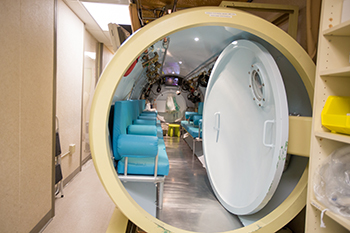
Wound healing is complex, with reduced or poor blood supply to the wound being a major factor that can slow or prevent healing, explained Walter Cholewczynski, MD, chief of the Center for Wound Healing and Hyperbaric Medicine at Bridgeport Hospital and clinical assistant professor of Surgery at Yale School of Medicine, shown outside one of the hospital’s hyperbaric chambers.
New, old, minor, deep. When it comes to healing chronic, complex or even seemingly superficial wounds, hyperbaric medicine may not be the first line of treatment that comes to mind. But at Bridgeport Hospital, hyperbaric medicine – best known for its use in decompression sickness – has found a role in the treatment of complex and hard-to-heal wounds.
From chronic bone infections and crush injuries to diabetic ulcers and radiation-damaged soft tissue or bone, hyperbaric oxygen therapy (HBOT) helps heal these wounds by bringing oxygen-rich plasma to tissue deprived of it.
“In our wound center, we specialize in treating patients who have difficulty healing from wounds due to diabetes, poor circulation, vein disease, trauma, infections, radiation therapy, autoimmune disorders and immobility,” said Walter Cholewczynski, MD, who is chief, Center for Wound Healing and Hyperbaric Medicine at Bridgeport Hospital, clinical assistant professor of Surgery at Yale School of Medicine, and affiliated with Northeast Medical Group. “Hyperbaric oxygen therapy is used to enhance wound healing. We use it as additional therapy in wound healing.”
Lessons learned
The principles behind HBOT have been around for years, since the building of the Brooklyn Bridge (1869-1883), when workers began to experience caisson disease, also known as decompression illness or sickness. “Most people are aware of hyperbaric medicine being used in divers who incur injuries from decompression sickness or ‘the bends,’” Dr. Cholewczynski said.
In scuba diving, the body takes in extra oxygen and nitrogen. If the nitrogen does not have time to clear from the blood as the diver ascends to the surface, it can, in some cases, be fatal.
“In scuba diving, hyperbaric oxygen therapy reverses adverse pressure changes in the bloodstream that can occur from ascending from deep water too quickly,” said Dr. Cholewczynski, who has used hyperbaric medicine in his practice for the past 13 years. “In patients with wounds, the extra oxygen helps fight bacteria and promotes healing.”
Who’s a candidate?
Using a team approach, Dr. Cholewczynski works with referring physicians and specialists who are board-certified in surgery, critical care, podiatry and other specialties as well as with a highly specialized team of physical therapists, physician assistants, scar management nurses and others to assess patients and create individualized treatment plans.
“Hyperbaric medicine is most commonly used in patients with diabetic wounds,” Dr. Cholewczynski said. One of the primary benefits is the increased concentration of oxygen in the bloodstream. It promotes wound healing by improving blood flow, enhancing growth factors and stem cells and reducing infection. Additionally, HBOT can speed up wound closure, leading to a quicker resolution of diabetic wounds.
“HBOT is also used in patients who undergo radiation,” he said. “This includes women who have had radiation to their chest wall following breast cancer surgery, and men who have had radiation for prostate cancer and are bleeding in their urine.”
HBOT has been shown to treat radiated tissue damage by regenerating blood vessels, re-populating damaged areas with new stem cells, and speeding up wound healing.
How does it work?

A look inside the hyperbaric chamber at Bridgeport Hospital.
“When a person goes in a hyperbaric environment, the amount of oxygen in their bloodstream is 10 times higher than normal,” Dr. Cholewczynski explained. “When you undergo the session, your body starts to respond to the oxygen like it’s a medication.”
This enriched oxygen environment promotes the development of new blood vessels, assists the white blood cells in fighting infections, reduces inflammation and promotes the growth of new tissue and skin within certain wounds and conditions.
“A patient who is a candidate for hyperbaric oxygen therapy goes into the hyperbaric chamber and breathes oxygen for 90 minutes,” said Dr. Cholewczynski. “The typical number of sessions is somewhere between 20 to 40 sessions,” he added. The treatment is generally administered one session a day, five days a week, as needed.
HBOT sessions are called “dives” – because they create conditions similar to submarines when submerged – but no water is involved.
Two types of hyperbaric chambers are available at Bridgeport Hospital and its Milford Campus: “One is called a multiplace chamber because it can hold up to six patients,” Dr. Cholewczynski said, noting that Bridgeport Hospital is the only hospital in the state with a larger, multi-person chamber capacity. Patients can read, sleep or watch television or a DVD. “At Milford Campus, we have two single or mono-place chambers, where the patient is able to lie down and watch movies.”
Expanding field
Although not all patients are candidates for hyperbaric medicine, researchers are investigating potential clinical areas that would benefit from HBOT. For example, HBOT has been shown to be successful in the treatment of sudden sensorineural hearing loss, a type of hearing loss that occurs due to a variety of causes, such as infection, head trauma or other medical conditions.
“Hyperbaric medicine has been around for a long time – in the past 10 years it’s become more well known,” Dr. Cholewczynski said. “More recently, the medical community has begun to recognize its effectiveness in healing wounds – and it is gaining a lot of recognition.”
Learn more about hyperbaric medicine at Bridgeport Hospital.
In addition to Bridgeport Hospital and Milford Campus, Yale New Haven Health offers hyperbaric medicine at Greenwich and Lawrence + Memorial hospitals.





